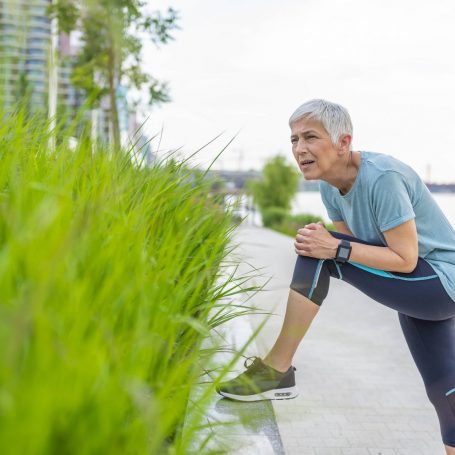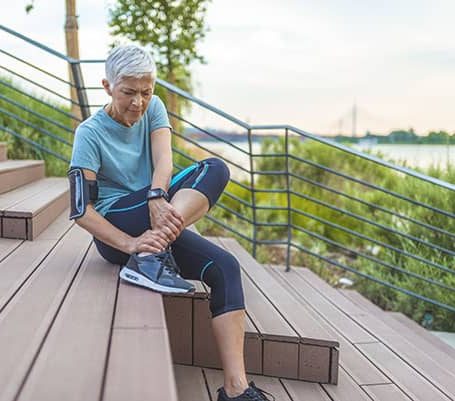CEO Medic‘s goal is to provide you with a better quality of life. All the services offered converge in this direction. Reducing pain and allowing you to obtain maximum mobility and comfort is our priority.
Do you have discomfort in your legs, feet or knees? Do not hesitate to consult our team. This is our specialty!
For your information, we offer here an overview of the most frequently observed pathologies.
Foot pain
Arthritis of the foot
Arthritis of the foot is the most common joint condition. The first symptoms often appear between the ages of 40 and 50, although the disease starts earlier. There are basically two forms of joint degeneration: rheumatoid arthritis and osteoarthritis. Rheumatoid arthritis is an inflammatory disease that affects the lining of the joints. Osteoarthritis is a degenerative disease that affects the joints.
Lenoir spine
Also called heel spur, Lenoir spine is a small bony growth that forms under the foot, where the fascia meets the heel. People who have it experience a point of pain, such as a thorn in the heel, which can make it difficult to engage in physical activities such as walking and running.
Plantar fasciitis
Plantar fasciitis is one of the most common conditions on the feet. It is inflammation under the heel that is associated with instability in the foot and ankle. The person who has it may experience heel pain from the first steps in the morning or after sitting for a long time.
Hallux valgus (bunion)
Hallux valgus, commonly known as bunion, is a deformity of the big toe. This is because the affected person has a lump on the side of the foot that can cause posture problems. The friction of bunions and shoes can also cause pain.
Metatarsalgia
Term used to describe pain felt under the forefoot, between the arch of the foot and the toes. Inflammation can be localized or distributed over the entire forefoot. There are many causes, but it is mainly a problem with the distribution of weight on one or more of the five metatarsal heads. Arthritis or a foot injury (sport or repeated movement) may also be involved.
Morton’s neuroma
Morton’s neuroma is said to be a mild ailment, but extremely painful. It is a disease that causes pain in the nerves in the front of the foot. We feel electric shocks and from having the nerves compressed, they become deformed.
Clubfoot
We speak of clubfoot when the foot is facing inward and the toes facing downward. This malformation is caused by an abnormality in the tendons and ligaments of the foot. It can affect one or both feet.
Hollow foot
This condition occurs when the arch of the foot is very high, which puts an inordinate load on the forefoot. This can lead to pain and instability in the ankle and foot. Hollow foot can be due to genetics or caused by a neurological problem.
Diabetic foot
Caused by peripheral neuropathy, diabetic foot can lead to amputation if improperly treated or neglected. To prevent an injury from going unnoticed and becoming infected, it is important for people with diabetes to properly inspect their feet and quickly identify signs of skin irritation, lesions or foreign objects. Any wound requires special attention: chapped skin, blisters, corpus callosum, ulcers, and gangrene (black necrotic tissue).
Flat foot
Flat foot is a very common condition among people. Discomfort can occur when standing or walking. Flatfoot is characterized by a sagging of the arch of the foot or the disappearance of the internal arch of the foot.
Sesamoiditis
This disease is characterized by inflammation in the plantar area, more specifically in the sesamoid bones, which causes pain. It is most commonly seen in dancers and people who run. We can associate sesamoiditis with tendonitis since there is inflammation of the tendons.
Are your feet hurting? Get an appointment quickly with one of our orthotists. With nearly 40 years of experience and development, our CEO Medic clinics use the best technologies to offer you a wide range of custom plantar orthotics. We also have a large selection of orthopedic shoes. One thing is certain, we are determined to help you regain your quality of life.
Our goal: Improve your quality of life
There are of course several other pathologies. Our orthotists will guide you to the right specialist and / or the right orthopedic device to help you regain your quality of life quickly.
Make an appointment now!Knee pain
Knee osteoarthritis (gonarthrosis)
Knee osteoarthritis is a disease that affects the joint through the gradual wear and tear of cartilage and bone. This leads to reduced flexibility, swelling and pain. The average age at diagnosis is around 50 for both men and women. The main causes: trauma (fracture, contusion, tear), joint stress (work, sport), knee instability, excess weight and sedentary lifestyle.
Ligament injuries
Often associated with contact sports and jumping sports, ligament injuries correspond to partial or total damage to the ligaments essential to the stability of the knee. Whether only one or both ligaments are affected, the symptoms are similar: swelling, sharp pain, and inability to put weight on the knee. A hematoma can also appear.
Knee sprain
We talk about a knee sprain when there is a stretch or tear of one or more ligaments. The severity of the condition affects the degree of pain and swelling in the knee.
Knee valgus
The knee valgus is defined by a position of the legs causing an inward arch. Both legs form an X when people are standing. The knees are in contact and the ankles are separated. This condition can therefore interfere with walking and can lead to knee osteoarthritis caused by forces exerted on the knee.
Knee varus
Knee varus is characterized by a position of the legs causing an outward arch. We identify people with varum knees by asking them to stand and stick their ankles together. This way, you can notice the space between the two knees.
Unstable knee
An unstable knee is often caused by ligaments hyperlaxity. This can cause the joint to malfunction, or even misalignment of the lower limb and slippage of the kneecap.
Iliotibial band syndrome
It is a very common injury, especially among runners and cyclists. This syndrome results from inflammation secondary to repeated friction of the band against the lateral femoral condyle (lateral side of the knee) during flexion-extension movements of the knee. It can cause pain and swelling on the outer side of the knee or hip.
Patellofemoral pain syndrome
This is characterized by irritation of the cartilages between the kneecap and the femur. It appears gradually following repeated and inadequate use of the knee joint or in people whose knees have poor alignment (deviation of the knee in varus or valgus). Depending on the case, the pain may be occasional or recurrent.
In case of pain, consult quickly. Our knee clinic offers you complete care and a personalized treatment plan. Learn about our orthopedic solutions. We also offer Cingal® viscosupplementation.
Leg pain
Lymphedema
This disease is characterized by swelling which is caused by an abnormal concentration of lymph fluid. People who suffer from it may also experience a feeling of heaviness or stiffness, pain, tightening of the skin, as well as reduced flexibility or mobility.
Leg edema
Manifested as swelling, edema usually affects both legs. It is usually linked to a malfunction of the blood system, especially the veins. It can also be caused by improper functioning of the lymphatic system.
Varicose veins
Varicose veins are non-functioning veins that result from poor blood circulation. Bluish in color, they usually appear on the legs. They can be concentrated in one place and / or manifest as a single apparent bluish vein. Varicose veins can be accompanied by swelling, itching, redness, and a feeling of pain, heaviness, or warmth.
Wearing stockings or compression garments can in most cases relieve pain or even reduce swelling. Our team will accompany you according to your needs. CEO Medic is also accredited by the RAMQ as a supplier in connection with the coverage program for compression garments aimed at treating lymphedema.












